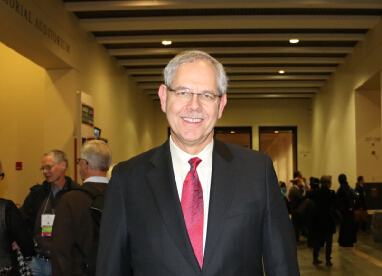当前位置:AASLD-美国肝病研究学会年会 » 正文
[AASLD2014] Scott L. Friedman专访:药物治疗能将肝纤维化逆转吗?
—— 作者:Scott L. Friedman 时间:2014-11-10 11:16:36 阅读数:
739

美国西奈山医院Scott L. Friedman教授访谈
《国际肝病》:您如何看肝纤维化、肝硬化的可逆转问题?
Prof. Friedman: Now that we have good treatments for viral hepatitis, we are learning a lot about the ability of the liver to reverse fibrosis and even cirrhosis. The liver has a strong regenerative capacity. What we would like to know more about is, what are the cells and enzymes that are responsible for that reversibility because we would like to take advantage of that knowledge to create new treatments. But there is no question that the liver has the capacity to reverse fibrosis.
目前我们在病毒性肝炎方面已有很好的治疗效果,并且对于肝纤维化甚至肝硬化逆转的认识也正在逐渐深入。肝脏是一个具有非常强的再生能力的器官。我们希望了解更多的关于肝纤维化逆转机制中起决定性作用的细胞和生物酶,这将有助于寻找到新的治疗方案。总之,我认为肝脏具有逆转纤维化的能力,这是毫无疑问的。
《国际肝病》:在肝纤维化和早期肝硬化的逆转中有哪些重要的因素?
Prof. Friedman: The most important is if the underlying disease can be cured or treated. The clear example is in hepatitis B and hepatitis C where we can suppress or cure the virus and the liver will start to regress. For other diseases, we are only beginning to learn about the factors that contribute to regression, but we know that the important cells include very specialized types of macrophages which may be important in breaking down matrix. In addition, crosslinking of matrix makes it more difficult to degrade, so if we inhibit matrix crosslinking, then that renders the collagen more susceptible to degradation. Also, the amount of injury to hepatic cells is also important in determining if fibrosis is more progressive or can regress.
我认为患者基础性肝脏疾病是否得到治疗和治愈是逆转肝纤维化和早期肝硬化的最重要的因素。举一个最鲜明的例子,乙型肝炎和丙型肝炎,我们目前已经可以通过治疗达到控制甚至治愈,使肝脏将重获新生。而对于其他肝脏疾病我们的认识也刚刚开始,其中某些特殊类型的巨噬细胞可作为肝脏再生中基质降解的重要环节。另一方面,基质的相互交联使得其降解更加复杂,如果我们将其抑制,那么胶原蛋白将更容易被降解。此外,受损的肝脏细胞的数量也决定着纤维化的程度和肝脏能否再生。
《国际肝病》:针对肝纤维化治疗的药物研究很多,但是临床上用于肝纤维治疗的药物很少,您认为其中的原因有哪些?
Prof. Friedman: There are, in fact, drugs under clinical study. The trial examining the FXR agonist, obeticholic acid, was reported in a trial published in the Lancet two days ago, that showed a significant decrease in fibrosis in patients on the drug. In addition, there are dozens of other new drugs that are either beginning or soon will begin clinical trials to reverse fibrosis. There is also a trial underway from Gilead Pharmaceuticals using an antibody that blocks crosslinking of collagen. So these are very exciting times because finally we are seeing these drugs enter into clinical trials and I am confident that more than one of them will ultimately be approved.
事实上,目前已有一些药物进入临床研究。Lancet杂志两天前刚刊登了一篇关于FXR 受体激动剂奥贝胆酸(Obeticholic Acid)的临床研究,结果显示该药在肝纤维化患者中有显著的作用。此外,还有大量的新药正在进行临床研究,Gilead公司正研发一种可以阻断胶原蛋白交联的抗体药物。相信我们在不久的将来有望看到一批新的抗纤维化药物应用于临床。
《国际肝病》:除了肝纤维化之外,肝脏炎症也扮演着重要作用,而针对炎症的治疗需要注意哪些问题?
Prof. Friedman: Many drugs that have antifibrotic activity are primarily targeting inflammation. If we can completely suppress inflammation, that should have a beneficial effect on fibrosis. For example, drugs that neutralize interleukins and drugs that neutralize chemokines will reduce the inflammation within the liver and will reduce the signals that drive fibrosis.
许多具有抗纤维化作用的药物最初就是用来抗炎的。若我们能够全面地控制肝脏炎症的发生,这对于肝纤维化的逆转也是有帮助的。例如,抑制白细胞介素和趋化因子的药物既可以减轻肝脏炎症,同时也抑制了肝纤维化相关的信号通路。
《国际肝病》:最近,有研究认为IL-17在肝纤维化中有重要作用,您能为我们介绍这方面的进展吗?
Prof. Friedman: Interleukin-17 is one amongst many inflammatory molecules that look very attractive as a target in liver disease. Much of the work has been based on animal studies and there is always a challenge translating animal studies into human studies. I think we still need to investigate it further. The biology looks very attractive and I am hopeful for its prospects.
标签:
访谈
专家访谈
肝纤维化
发表评论
全部评论

- qingyi8203292014-11-27 16:11
- 关于扶正化瘀那段没有文字记录

- qingyi8203292014-11-27 16:11
- 关于扶正化瘀那段没有文字记录